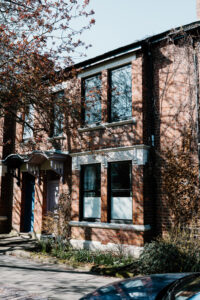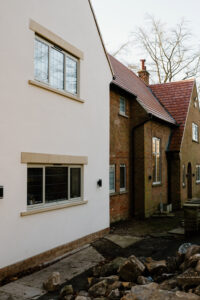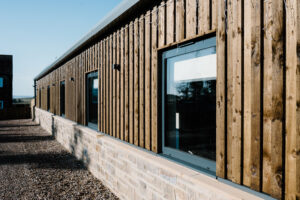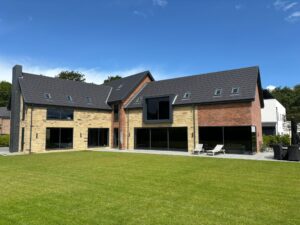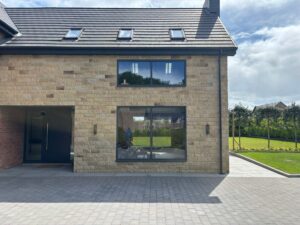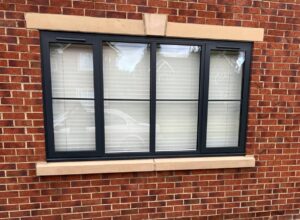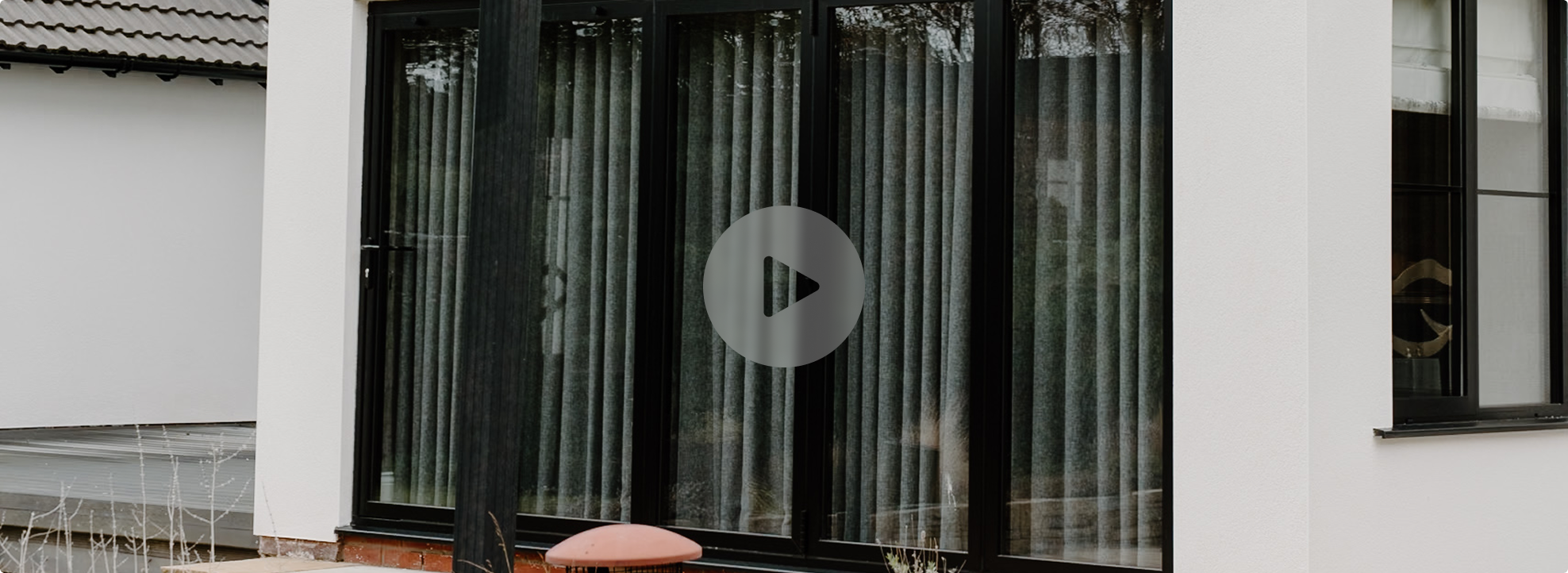Trade Pricing & Exclusive MKM Access
Aluminium Tilt & Turn Windows
Convenient ventilation and easy cleaning in one sophisticated product
Aluminium Tilt & Turn Windows offer a combination of convenient ventilation and easy cleaning in one sophisticated product. The tilt & turn mechanism allows the window to tilt inward from the top for gentle ventilation or swing inward like a door for full opening and access. This dual functionality makes tilt & turn windows extremely popular in many European countries and increasingly sought-after in the UK for modern apartments, upper floors, and where egress or internal cleaning is needed. BM Bifolding Doors manufactures tilt & turn windows using high-quality thermally broken aluminium (such as the Smart systems) which ensures slim, stylish frames alongside robust performance. They are ideal for high-rise applications, contemporary homes, and anyone who values versatility – you can enjoy a secure ventilation mode without fully opening the window, or open it wide to refresh the room or clean the outside glass from inside. With our Aluminium Tilt & Turn Windows, you get German-inspired engineering with British-made quality, all custom-sized to your project.
-
Dual Opening Modes: A simple turn of the handle lets you choose how the window opens. Turn it to the first position and the window tilts inward at the top – providing ventilation while still keeping the window secure and rain out (great for ventilating on a drizzly day). Turn the handle further and the side hinges engage, allowing the window to swing inward like a door, granting a large opening for maximum airflow or emergency escape. This versatility is a hallmark of tilt & turn design, offering unmatched flexibility in how you use your windows.
-
Safe & Easy Cleaning: Especially for upper-storey windows, tilt & turn is a game-changer – when swung open inward, you can easily clean the exterior glass from inside your room. No ladders or leaning out dangerously required. This makes maintenance a breeze, and is also safer for high-rise living. Additionally, the tilt mode provides ventilation without the safety risk of a wide-open window – ideal for those with children or pets, as the narrow opening at the top is too small to climb through while still giving fresh air.
-
Airtight & Energy Efficient: When closed, our aluminium tilt & turn windows seal tightly on multiple gaskets all around the frame. The engineering ensures excellent air and water tightness (multi-locking points pull the sash closed evenly). This contributes to high energy efficiency and sound insulation – your home stays warm and quiet. The thermal break aluminium frames and quality double glazing further keep U-values low, comparable to our other window systems (typically achieving Window Energy Ratings of A with appropriate glass). So you get the convenience without any compromise on performance.
-
Strong, Durable Hardware: Tilt & turn mechanisms handle large, heavy sashes, and we use proven hardware (often European-made) that operates smoothly and stands up to repeated use. The heavy-duty hinges and gearing are largely concealed, giving a clean look and requiring minimal maintenance. They are designed to carry substantial weights, meaning we can make fairly large tilt & turn windows without worry. Plus, features like multi-point locking around the sash provide enhanced security – these windows lock at several points, not just one, making them very secure against forced entry.
-
Contemporary Aesthetics: Aluminium tilt & turn windows complement modern architecture nicely. They have a clean, flat profile and our frames are slim, maximising glass area for light. From the outside, they can look just like a fixed window (no obvious hinges) which many architects appreciate for uniform facades. From the inside, the larger single-sash style (often tilt & turns are made as one large pane rather than divided lights) gives you wide unobstructed views. And of course, aluminium’s sleek look and extensive colour options allow these windows to become an architectural feature or blend in as desired.
For Trade Professionals
We supply many tilt & turn windows for projects like apartments and office builds, and we ensure our trade clients get a product that’s straightforward to install and adjust. Each tilt & turn unit is factory-assembled and tested for smooth operation before it goes out – we double-check that the tilt function and turn function engage correctly and that clearances are perfect. As an installer, you’ll find our tilt & turn frames come pre-glazed where possible, with the handle and locking mechanisms already fitted and adjusted, so on site it’s mostly about securing the frame and final tuning. Speaking of tuning: tilt & turn hardware has adjustability – we can guide you on using the adjustment screws on the hinge to tweak sash alignment if needed. Our windows come with all necessary brackets and instructions. Trade customers also benefit from the fact that we use high quality hardware (often from brands like Siegenia or Sobinco) known in the industry – so replacements or additional parts (like child-safety catches or trickle vent add-ons) are accessible if needed. And while aluminium tilt & turn might be a premium product, our pricing for trade is competitive, enabling you to upsell from PVC alternatives especially highlighting the longevity and strength benefits. We can assist with specifications – if you have a requirement, say, for a certain size that needs a stronger hinge or a specific acoustic rating, we likely have solutions at hand. Additionally, we know that sometimes these windows go into complex curtain wall or combination frames; we coordinate with those systems easily. By partnering with BM Bifolding Doors for tilt & turns, you get reliability and support – fewer call-backs for sticking or misaligned windows, and a product that impresses your clients with its solidity and function. We have also kept up with building regs like fire escape egress – ensuring that if a certain clear opening is required for a bedroom, our design will meet it (we consider hinge placement and sash sizing accordingly). All in all, you can trust us as your source for quality aluminium tilt & turn windows that will enhance your project’s reputation.
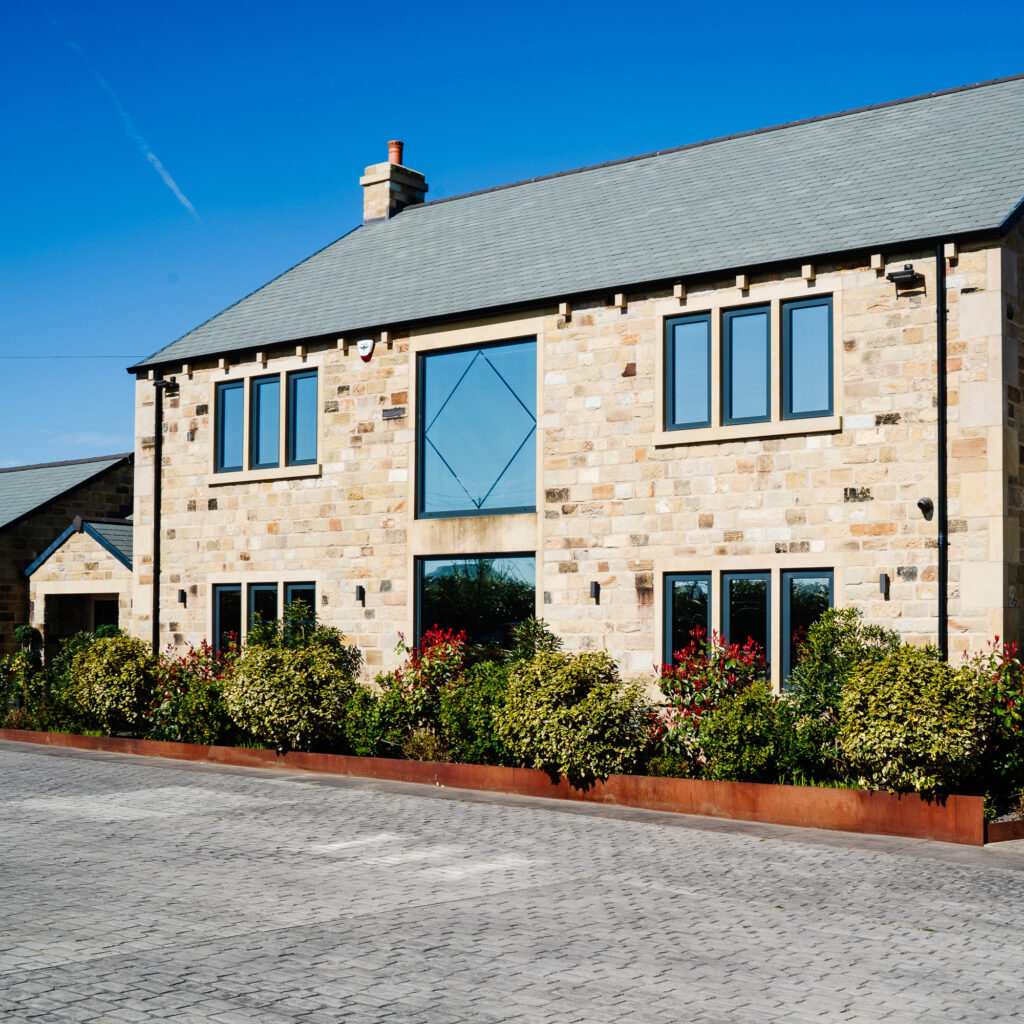
For Homeowners & Business Owners
If you’re considering tilt & turn windows, you likely value practicality and modern design. Homeowners particularly on upper floors or in flats will love how tilt & turns function. Day-to-day, many use the tilt mode for secure ventilation – you can leave the window tilted open a bit even when out of the house, since it’s very difficult for an intruder to exploit that small opening (plus our tilt locks are strong). It’s also great during light rain – the rain typically won’t come in while tilted, so you can still ventilate. Then for a big spring cleaning, swing it open and you have full access to clean both sides or to pass bulky items through if needed. Also worth noting, tilt & turn windows are great for fire escape in upstairs bedrooms: when fully open, they can provide a large exit space. Many homeowners like them for basement egress windows too (though those often open inward fully like a door for escape). Business owners might use tilt & turns in places like hotels (where guests can get fresh air but not open fully for safety) or in offices where cleaning windows externally is hard – this solves it. One thing you’ll notice is the quality feel – the mechanism is smooth and almost feels “commercial grade” because it is. When you operate the handle, you can sense the multi-lock points engaging; it’s a solid feel unlike some flimsier windows. Maintenance is minimal – just occasional lubrication of the hinge parts and checking the gaskets. The aluminium frames won’t need painting and won’t rot, so especially in larger urban buildings or coastal areas, you get longevity. In terms of style, while PVC tilt & turns exist, the aluminium ones just look sharper – slimmer frames, no bulky plastic look – enhancing your property’s appearance. They also pair well with other glazing like fixed aluminium windows or doors, so if you have a mix (say fixed panes and some tilt & turn openers for ventilation), they’ll all match in look. Homeowners often comment on how much quieter and draft-free their rooms are after installing these – that’s due to the tight seals and quality construction. It’s an investment in comfort, convenience, and safety. Plus, if you ever sell your property, potential buyers may appreciate these modern windows (tilt & turns are often seen as a premium feature).
Everything you need to know about Smarts Visofold 1000 Bifolding Doors
Yes. Our platform offers a wide range of set-size bifolding and sliding doors for fast-track delivery, alongside custom-size products tailored to your exact measurements. Simply choose the product type, select the size option, and configure your specification.
Each product page includes detailed descriptions, specification options, and recommended use cases. Whether you need corner bifolds for an extension, heritage sliders for a period home, or Alu Elite internal screens, our team is on hand to advise and help you choose the most suitable product.
Set-size products like our Fast Track bifold and sliding doors are typically delivered within 3–5 working days. Custom-size and specialist items such as gable windows or luxury garden rooms usually have lead times of 3–6 weeks, depending on complexity and volume.
Most external aluminium products (bifolds, sliders, French doors, windows) are supplied pre-glazed and partially assembled for ease of installation. Internal systems like Alu Elite doors and screens may be delivered in kit form with full fitting instructions.
Yes. All of our aluminium systems meet or exceed UK standards, including Part L for thermal efficiency, Part Q for security, and PAS 24 certification on selected models. Certificates and technical documentation are available on request.
Absolutely. The site is designed for both trade professionals and self-managed domestic customers. You can purchase any product online, and if you need help with measuring or specification, our team is happy to assist.
Yes. We offer supply-only as standard, but installation services can be arranged in many areas via our approved installer network. Alternatively, products come with detailed fitting guides suitable for competent installers or builders.
All products are backed by BM’s manufacturer warranty:
-
10 years on aluminium frames
-
5 years on double glazing
-
25 years on powder-coated finishes
Full warranty terms are provided with your order.
Yes. MKM trade customers can apply for a dedicated trade account, unlocking exclusive pricing, bulk discounts, and faster quoting tools. Speak to your local MKM branch or apply directly through the site.
You can visit selected MKM branches or our Middlesbrough showroom to view popular products in person. We also offer brochures, virtual product tours, and sample finishes on request.
-
Handle Operation: A single handle controls both functions. Typically, from locked position (handle down) – turn handle 90° upward and the top tilts in (~100mm or so, limited by restrictors) for ventilation. Return to closed, then turn handle 180° (pointing up) and the side hinges engage to allow full inward swing. There are safety interlocks to prevent misuse (for example, it won’t let you turn to swing mode while it’s tilted – you must close it first). Handles usually have an indicator of positions and can be key-lockable if desired for security or child safety.
-
Size Capacities: We can manufacture fairly large tilt & turn sashes – often up to 1.5m wide by 2.4m tall per sash, depending on weight (these are heavy with glass, so typically there are recommended limits around 100-130 kg per sash for safe operation). If a window is larger than the hardware limits, we might split it into two sashes or include fixed lights. But rest assured, you can get big, floor-to-ceiling tilt & turns (common in modern homes as Juliet balcony doors – they turn open like a door for balcony access, and tilt for vent) – in fact, many use them as an alternative to French doors where space doesn’t allow outward opening.
-
Ventilation & Micro-vent: In addition to the tilt mode, some hardware allows a “night vent” position – a very slight jar (a few millimeters open) while handle locked – but on these windows, the tilt is effectively the vent mode. It provides abundant airflow but in a controlled, upward draft manner (air comes in through top). This is more secure than a fully open casement since the opening gap is small and at the top, but note: it’s not security-proof, just more secure. We also offer trickle vents integrated into frame if required by building codes (though the tilt function often suffices for background ventilation, trickle vents might still be mandated).
-
Security Features: Tilt & turn windows feature multiple locking cam rollers around the perimeter. When closed and handle locked, these cams engage keeps, pulling the sash in snugly. This multi-point system is inherently secure. We use mushroom-head locking bolts that resist forcing. Hinges are very robust; plus, because these windows open inward, any attempt to push them from outside when locked is futile (they only open inward). For added measure, we can fit things like a tilt restrictor or child-safety catch which limits how far it swings (helpful in preventing a child from fully opening it unless a catch is released).
-
Tilt & Turn vs. Other Styles: These windows essentially give you two functions in one, which is their major benefit. They do have slightly thicker frames than a fixed window or basic casement, because of the hardware groove. But our modern systems have slim profiles considering the functionality. They also have an almost flush exterior (since they don’t open outward, there’s no sash protruding outside except maybe 1-2mm for gasket). This gives a neat external appearance, good for minimalistic designs or if you want the window to sit behind external cladding etc. One thing to be aware: they open inward, so you need interior space clearance (can’t have big objects or plants that would obstruct it when swinging in). But for many, that’s a minor consideration compared to the benefits.
Our aluminium tilt & turn windows can be finished in the full range of colours just like any of our window products. Since these often go in modern settings, we frequently do them in neutral modern colours – charcoal greys, jet black, pure white. However, they’re fully customisable, so if your decor calls for a bronze, silver, or even a bold red, we can do it. Many high-end apartments might opt for a metallic or anodic grey finish for a chic look – we can supply anodised finishes if specified (those give a nice metallic sheen and ultra-durable finish). If you want the inside a different colour than outside (maybe outside to match building facade, inside to match room interior), we can do dual-colour with no issue due to the thermal break allowing separate coating. The handles typically come in standard colours (white, black, silver, etc.) – we’ll choose a handle finish that complements the frame (or special-order a custom handle colour if needed). All coatings on our windows meet Qualicoat standards for quality, meaning they won’t peel or flake and have excellent colour retention. Especially for tilt & turns which often have large sash frames, the finish quality is evident – smooth, even coating is our standard. If part of a larger project, we ensure your tilt & turn windows match any other aluminium elements (doors, other windows) in colour and gloss level perfectly. Simply let us know your desired colour or if you need samples, we can provide. We’re seeing a trend of some clients choosing a specific interior colour for these – e.g., a warm white inside to blend with walls, while having a darker external frame for contrast – that’s easily achievable. No matter what, the colour you choose will be factory applied and baked on, giving a maintenance-free beautiful appearance for the long term.
We glaze our tilt & turn windows with high-performance units comparable to our other windows. Because these windows often can be larger, we pay attention to glass strength – using appropriate thickness (e.g., 6mm glass instead of 4mm for bigger panes to reduce deflection). As standard, they’ll have a double-glazed unit with low-E coating and argon gas for energy efficiency. Given tilt & turns are often used in noise-sensitive urban builds, we can also do acoustic laminated glass configurations to dampen sound (many city apartments appreciate the near “silence” when windows are closed). Safety wise, if a tilt & turn is large enough to be considered a door or low window, we’ll use toughened safety glass as required by regs. Tilt & turns in upper floors not usually a human impact risk, but we still often use toughened for those big panes for safety in case of accidental breakage. If your building has specific requirements (like triple glazing for Passivhaus-level performance), our systems can accommodate that – we’ll adjust gasket and bead to thicker units. The seal of the window combined with quality glass also nearly eliminates drafts and condensation – a big difference if you’re upgrading from older windows. For UV or solar concerns (like in an office with computers near window or a home with lots of sun), we can offer tints or solar control coatings to reduce glare and UV ingress. But often, the advantage of tilt & turn is you can open it fully if it’s too warm anyway! If desired, we can integrate blinds inside the glass, though generally with tilt & turns people opt for external blinds or none at all (since cleaning outer glass is easy, regular blinds suffice). All glass units have warm-edge spacers to cut down condensation. And if privacy is needed (like bathroom tilt & turn or a window facing a neighbor), we can use obscured glass. Ultimately, we’ll choose the right glazing spec to optimize energy, acoustics, and safety for your specific application – making your tilt & turn windows as high-performing as the frames themselves.
For more detailed information, you might look at our Tilt & Turn Window Product Brochure, which outlines the mechanism, benefits, and options (if not directly on our site, we can send you a manufacturer brochure from the system supplier). We can also provide technical specification sheets – for instance, a hardware guide that shows how the tilt/turn mechanism works, or the Smart Tilt & Turn Window datasheet if we’re using Smart’s system. For architects or engineers, we have section drawings and test certificates (air/water/structural performance data) for these windows – often included in our technical catalogue or available on request. If you’re installing these, our Installation Guidelines (available in the downloads or manual) will help, although they install similar to other windows with the addition of adjusting the hinge and lock cams which we detail. Also, a User Guide for the end-user might be in our downloads – explaining how to operate tilt & turn handles properly (very handy for new users who might not have seen this type of window before). We encourage prospective buyers to check out these documents or ask us for them – once you see the design and testing behind tilt & turns, you’ll understand why they have such a solid reputation for performance. All the relevant downloads are accessible in our resource section, and of course, our team is always here to answer questions if something isn’t covered in a brochure or you need project-specific advice.


